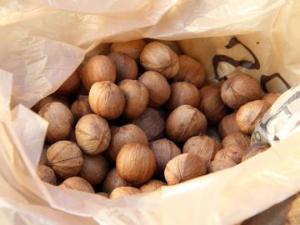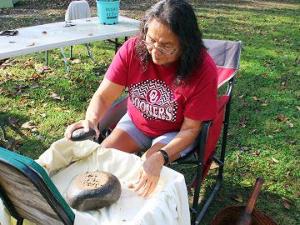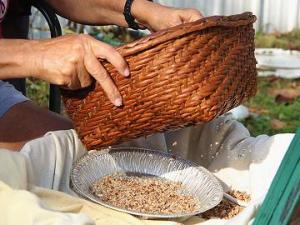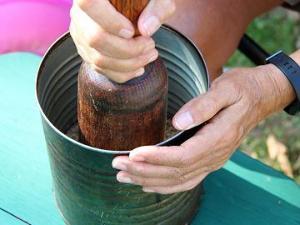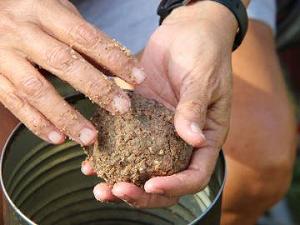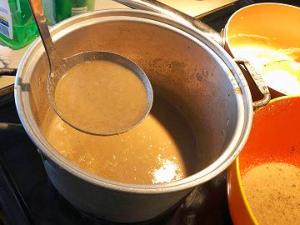 |
Canku Ota
|
 |
|
(Many Paths)
|
||
|
An Online Newsletter
Celebrating Native America
|
||
|
NovemBER 2020 - Volume
18 Number 11
|
||
|
|
||
|
Cherokee Eats: Kanuchi
|
||
|
by Lindsey Bark - Reporter
Cherokee Phoenix
|
||
|
credits: photos by Lindsey
Bark - Cherokee Phoenix
|
KENWOOD – A staple food that Cherokees look forward to in the fall is kanuchi, a hickory nut soup. Cherokee Nation citizen Roberta Sapp makes the well-known dish annually, having learned the tradition from her grandfather. Gathering: "Kanuchi is like a dessert, a sweet drink that has rice in it or has hominy in it," Sapp said. "You gather hickory nuts, then you clean them and crack them as small as you can." Hickory nuts are usually gathered in the fall, cleaned of their husks and sometimes dried before being used. Process: When cracking hickory nuts, tools are needed
to make the process easier. "I grew up around my grandpa making it all the time," she said. "He handed over his rocks that he cracked them with, and his stick that you mash it with and the old basket that he sifted with." Sapp places one nut at a time in the center of a large oval stone that is flat on top. Then she uses a smaller similar stone to pound the hickory nut until it is completely crumbled. Once enough nuts are cracked, she takes the basket and sifts the meat from the shells. Any leftover shell pieces are picked out by hand until mostly nutmeat is left, slightly more than a handful. Sapp places the meat into a bowl-like object to begin the mashing process. She uses an old coffee can with a thick metal piece welded to the bottom. She uses the stick to mash the nutmeat until the oil is released and can be formed into a 3-inch to 4-inch ball. Kanuchi balls can be refrigerated or frozen and last up to two years, Sapp said. Cooking: The kanuchi ball is broken into a bowl with hot water and stirred until it has a soup consistency. The soup is then strained of all the nutmeat before being added to cooked rice or hominy. "Once the ball is made, I boil water, cook my rice," she said. "When the rice is ready I'll smash the ball back up and pour my hot water in there and then I'll strain it into a pan. You keep going until all the meats gone. Then you put rice in it." Kanuchi can be eaten hot or cold and sugar added for taste. "There's a lot of people that like it," Sapp said. "But I guess since it's like a sweet drink, you can either drink it or eat it with a spoon, with the rice in it. It has a really good taste, the hickory nuts do. Even if you crack them and eat them, they have a really good taste." Tradition: Sapp has been making kanuchi for about 50 years. She intends to pass her tools down to one of her daughters, who also makes the dish. "My daughter Tina can make it and we'll probably pass this stuff on to her. When we can't do it no longer we'll probably give it her." Sapp said it's important for younger kids to learn traditions such as kanuchi. "I think it is really important for the younger kids to know since it's like an old Indian drink. That's how I look at it. It started from somebody way back probably. Sometimes I wish I had asked questions but I never did. Even the basket I have, I don't know who made it or how long they had it. It's different. It's not like what we make. But I think it's important to pass it on to one of your kids if they want to learn it. If not, then pass it on to one of your family members that will do it and keep it going." |
||||||||||||||||||
|
|
|
|
||
|
|
||
| Canku Ota is a free Newsletter celebrating Native America, its traditions and accomplishments . We do not provide subscriber or visitor names to anyone. Some articles presented in Canku Ota may contain copyright material. We have received appropriate permissions for republishing any articles. Material appearing here is distributed without profit or monetary gain to those who have expressed an interest. This is in accordance with Title 17 U.S.C. Section 107. | ||
|
Canku Ota is a copyright ©
2000 - 2020 of Vicki Williams Barry and Paul Barry.
|
||
 |
 |
|
|
The "Canku
Ota - A Newsletter Celebrating Native America" web site and
its design is the
|
||
|
Copyright ©
1999 - 2020 of Paul C. Barry.
|
||
|
All Rights Reserved.
|
||
